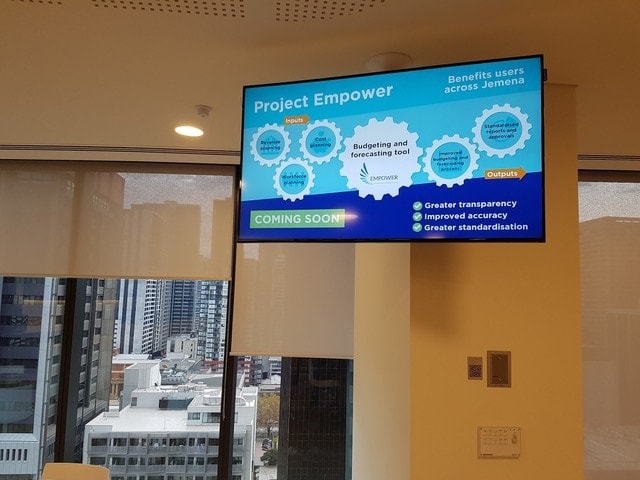
Filed under: Intranets, Latest Features
When you look for it, you find digital signage everywhere within today’s organisations.
There are screens in the foyer and behind the front desk. Messages flash by during the idle minutes spent in a lift. There’s a screen in the entryway on each floor, and more in the kitchenettes. Screens are very prominent in the call centre, and they are starting to appear in the depot and other frontline areas.
There is a danger that these screens have quietly been added over time, with a mix of technologies, and a range of ways to manage them. This generates a lot of extra work, but misses out on the true opportunities that digital signs offer.
What’s needed is for digital signage to be a clear part of the digital channel strategy for internal communicators. Following five best practices will maximise the impact and value of the signs.

Digital signs are often seen in kitchenettes and cafe areas, giving a captive audience. Photo courtesy of Jemena
Visibility but confusion
In one organisation we know, dozens of new display signs were bolted onto walls throughout the office. These were purchased in isolation of any broader internal communications or IT strategy.
The result? The screens could only be updated by putting in a USB memory stick with the new images. By hand, one screen at a time, with no ability to properly network the devices. Ouch!
At the other end of the spectrum, a large business rolls out a remarkable new intranet. Central to this is a rich and highly visible news feed, tailored to match individual interests. The display screens already in place throughout multiple buildings? Forgotten, and left to be run separately, without any alignment to what was appearing on the intranet.
Both of these examples show the challenges that many organisations face when it comes to delivering messages to digital signage.

Key corporate messages and projects can be highlighted on digital signage. Photo courtesy of Jemena
Five best practices
Digital signage plays an important role in a holistic internal communications strategy, as it has the ability to reach a wide audience at a time when they’re not concentrating on their jobs.
To get the most out of digital signage, follow these best practices:
- Integrate signage with other digital channels. This should enable messages to be easily created once, and delivered to multiple channels, such as screens, mobiles and the intranet. With a truly modern intranet, it should be possible to use this as the single source of truth across all devices.
- Tailor frequency according to location. Messages should rotate every few seconds in a lift, but perhaps change only once a day in the foyer. Assess how long people will be spending in a location, and how much you want them to see.
- Target messages to ensure relevance. There will be some messages that should be communicated everywhere, from the foyer in head office to field depots. Most messages, however, should be targeted according to staff group and location. For example, the call centre is likely to get very different messages, as is the floor of IT staff.
- Establish a style guide and templates. It’s often not possible or practical to craft each slide as a work of art. Instead, teams should create a set of simple templates that allow messages to be ‘dropped in’. Consider using tools such as Canva where more crafted messages are required.
- Use humour! Experience has shown that messages conveyed with an engaging personality and sense of humour have the highest recall and impact. Digital signage is a highly visual medium, so don’t be afraid to have a bit of fun!

A sample template for digital signage, showing how the addition of words and a graphic can create a high impact output.
It’s a journey
Your use of digital signage will evolve over time, like the intranet and the other digital channels. Start by bringing it into your strategic planning, and clarify when the signs should be used, and for what messages.
Aim to enhance the use of the signs over time, as new technologies become available. Improvements to the intranet, and the move to a broader digital workplace will also help.
But always remember: regardless of the medium, it’s about informing and engaging, with an authentic style and a sense of humour!





